Escapades at El Boquerón Izabal & Cañon Seacacar
Is El Boquerón Izabal worth visiting?
The jungly peaks of the Sierra de Santa Cruz ring the northern edges of Lake Izabal, Guatemala. Between these steep slopes courses a powerful river. It froths over boulders, swirls in forceful currents, and slices a path between mountains that rise up to 700 feet on either side. This is El Boquerón, a narrow limestone gorge, magical in its beauty, with plenty of opportunities for hiking, camping, tubing, and canoeing to add to its attraction.
If you like nature and outdoor activities, this could be the destination of your dreams.
Table of Contents
Best spots to access El Boquerón
Balneario El Boquerón
– How to get to the Balneario
Reserva Natural Cañon Seacacar
– Tubing through El Boquerón Izabal
– Hiking atCañon Seacacar
– Camping at Reserva Natural Cañon Seacacar
– How long to stay at Reserva Natural Cañon Seacacar
– Costs atReserva Natural Cañon Seacacar
– Important Things to Know about Cañon Seacacar
– Interesting Facts aboutReserva Natural Cañon Seacacar
– Contact information for Reserva Natural Cañon Seacacar
– How to get toReserva Natural Cañon Seacacar
Tour companies that lead tours to El Boquerón
Places to stay near el El Boquerón Izabal
Is it safe to visit El Boquerón Izabal?
Best time to visit El Boquerón
Climate at el Boquerón
Nearby Attractions
The Wrapup
Best spots to access El Boquerón Izabal
There are two places you can access El Boquerón Izabal. The first is where the Sauce River emerges from the canyon and flattens out before continuing at a more placid pace towards the lake. There are two balnearios (bathing spots) just off the road with picnic tables, bathrooms, a store, and green areas. Balneario El Boquerón offers visitors the option of a short boat tour up the river to see the impressive limestone cliffs that make this spot one of Izabal’s great attractions.

The other option is to drive partway through the Sierra de Santa Cruz and down into the river gorge above El Boquerón. Here you’ll find an inspiring community tourism project that possesses a rare touch of excellence. It’s known as the Reserva Natural Cañon Seacacar (say-ah-kah-car), and unless you’re strapped for time, it’s what I recommend be your top choice.
I’ll talk about both access points, what you can do at each, and why you might want to visit one over the other.
Balneario El Boquerón Izabal
If you want to visit El Boquerón but don’t have a lot of time for more than a couple-hour stop, heading to the Balneario is a great option. It is just off the road between El Estor and Río Dulce. It’s easy to access and is an economical option.
Activities at Balneario El Boquerón
There are lots of picnic tables at the Balneario if you want to have lunch in this pretty spot, you can also swim in the river, camp, explore the rocky limestone shore of the canyon, or go on a boat tour a short way upriver for a look at the stunning cliffs of El Boquerón.
If you are a strong swimmer, or the water is low, you may also be able to swim upriver yourself to skip the boat tour fee.

Costs at Balneario El Boquerón
Q5 per person for the entrance fee
Q15 per person for a canoe trip into the canyon
Q10 for parking (per vehicle)
Q20 to camp
How to get to Balneario El Boquerón
To get to the Balneario, simply head west from Río Dulce and drive about 45 minutes. Before you reach the bridge over the El Sauce River, you will turn right into the picnic and recreation area known as Balneario El Boquerón. Alternatively, cross the bridge and turn right to access Balneario Tío Polo on the opposite side of the river.
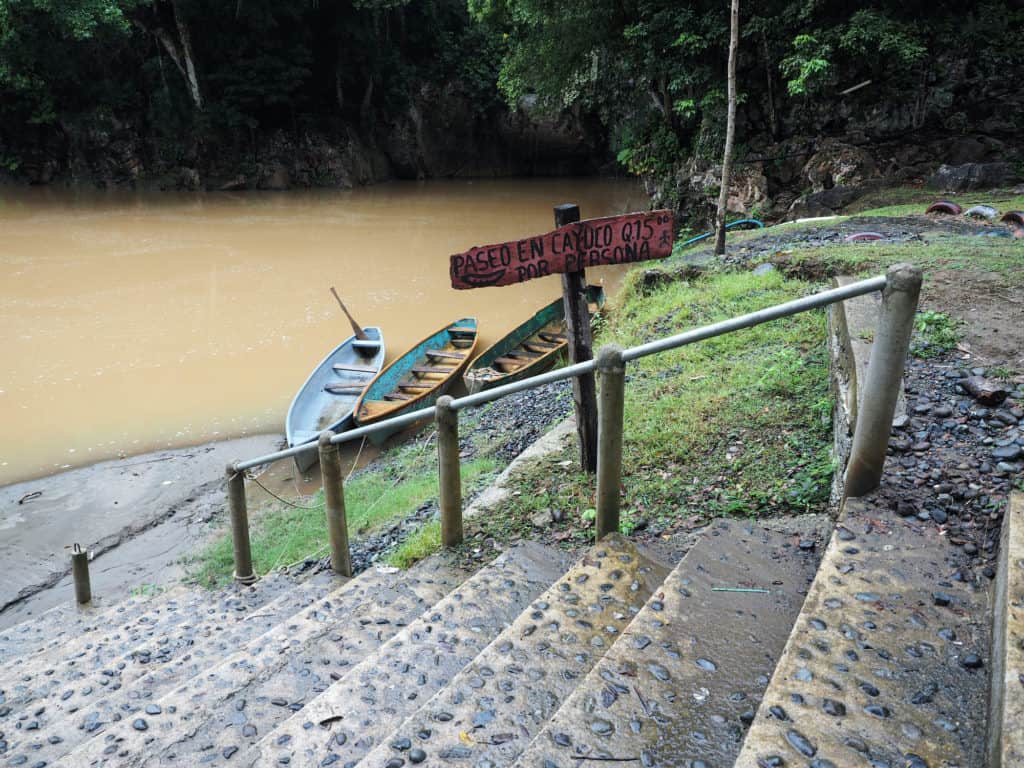


If you are going to El Boquerón on public transportation, you can catch a bus from Guatemala City to Río Dulce, then find a microbus going to El Estor. You can catch one by going to the intersection of the main highway through Río Dulce and the highway to El Estor. The trip costs Q20. Get off at the Balneario marked below on maps:
Reserva Natural Cañon Seacacar
If you have a day or more to visit El Boquerón, I highly recommend going to the Reserva Natural Cañon Seacacar instead of going to the Balneario.
This is an awesome and beautiful place upriver of the El Boquerón gorge, with a restaurant, dormitory, hotel rooms, hiking trails, and tours, all run by and for the community.
Proceeds from tourism go towards the community school, scholarships for students from the El Sauce watershed, reforestation, and improvement of the tourist center.

Graduates of the school have gone on to better and brighter futures and several of the community youth have invested in the project by becoming managers and guides. The people I met during my stay were welcoming, professional, and accomodating.
Why not visit this cool place and help build up the local community while you’rehaving an amazing time? That’s what I’d call a win-win situation.
Tip: The community tourism project of Panimatzalam in Sololá is also worth checking out.
Tubing through El Boquerón Izabal
Tubing down El Boquerón was definitely the highlight of my trip. Fourteen of us donned our bathing suits in the misty December weather and then headed over to the community school to meet our guides. There were four of them, one for every five people and an extra because we had kids with us.
The hike down to the tubing point
We got fitted for life jackets, got our tubes, and then walked down a trail for about 20 minutes. Parts of the trail were slippery with mud, interspersed with concrete sections, wooden steps, and bridges. It was a pretty walk, with lots of chances to admire the lush vegetation, strange rock formations, and the river plunging between its stone channel to one side of us.

At the end of the walk, one of the guides told us how to maneuver the rapids (stretch out and hang on!) and then we walked down the steps and plopped onto our tubes, yelping a bit at the cold. We formed a chain until everybody was in the water, and then released one by one. We were off!
Tubing down El Boquerón Izabal
Brown water swirled around me as I floated downstream in the strong current, awed by the sight of the canyon lunging up and up towards a narrow band of sky. Roots and tree trunks and plants dangled from far above me, a soft mist fell through the air, and a huge tree-covered boulder perched atop a smaller boulder, like something out of a science fiction movie.
The current picked up, a guide directed me into the rapids and said: “estiráte” (stretch out). I stretched out over my tube and hung on as the water got fast and choppy, zooming me beneath beautiful canyon walls.
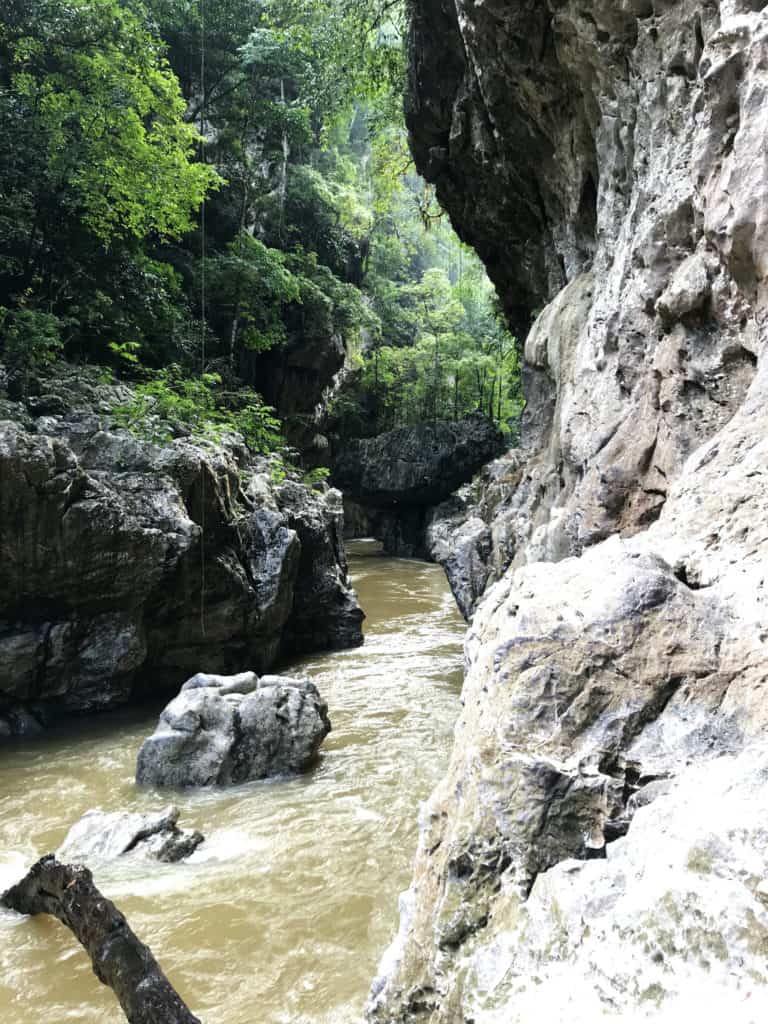
The current slowed and sped up again a couple more times before the river emerged into the relative flatlands surrounding Lake Izabal.
Note: Since it had been raining so much, the water was high and milk chocolate brown rather than its usual clear green. We also probably had a much quicker tubing experience because of this. I spoke to a friend who had been to El Boquerón in February several years ago and she said the tubing was so slow you had to paddle to help yourself along.
Returning upriver by boat – battling rapids
We all wished the tubing had been longer, but going back upriver by boat turned out to be almost as much fun. We piled into two fiberglass boats, with a single boatman at the back to paddle the weight of nine people against the current. We were curious how one person would manage it since the current was strong.

When we reached the bottom of the first rapids section, we all piled out and walked over sandbanks, then back into the river, struggling through the current while the boatman, our guides, and various of us helped haul the boat through the chop, push it away from boulders, and get it to a spot where we could pile in again.
We got in and out of the boat several times, and it proved a fun challenge with lots of laughs and jokes and people falling over in the water, and one of the guides losing his shoes.
By the time we got back to the spot we’d started tubing (by reaching out to pull our boat along the cliff wall), the whole experience felt satisfying and complete. I’d do it all again in a heartbeat. Plus it was wonderful to see the canyon again from this different vantage.


We hiked back through the misty rain to drop off our tubes and went for a quick dip in the river before eating lunch, still chatting animatedly about our favorite parts of the tour.
Hiking above El Boquerón Izabal
One of the advantages of going to Reserva Natural Cañon Seacacar is that the community has built a nature trail and two overlooks that are about 2,952 feet above the river.

The path is very steep, technical at times, with rocky steps, a few muddy sections, and lots of switchbacks. Make sure you take good hiking shoes! However, I was impressed with how well-built the trail was. The vast majority of the path was a mixture of concrete and stone that made for good traction. It was also well-marked and wound its way past a ceremonial cave full of bats, and through the lush tropical rainforest. I loved taking a closer look at the plants along the way.

There were a couple of times in the woods when, if I stood in a particular spot, the air smelled intensely and inexplicably like freshly ground black pepper. I asked one of the tubing guides about this and he said it was the rocks. I don’t know how that could be, but I would love to find out.
The two overlooks offered beautiful panoramas of the canyon and Lake Izabal in the distance. It was definitely worth the effort!
Camping at Reserva Natural Cañon Seacacar
My family and group of friends had a great time camping at El Boquerón at Cañon Seacacar. We were lucky in that we were the only visitors, so we got to pitch our tents in the restaurant and under the roof of one of the bars. It would have been a very wet, muddy, and miserable trip otherwise since we were there during one of the rainiest times of the year for the area (December).
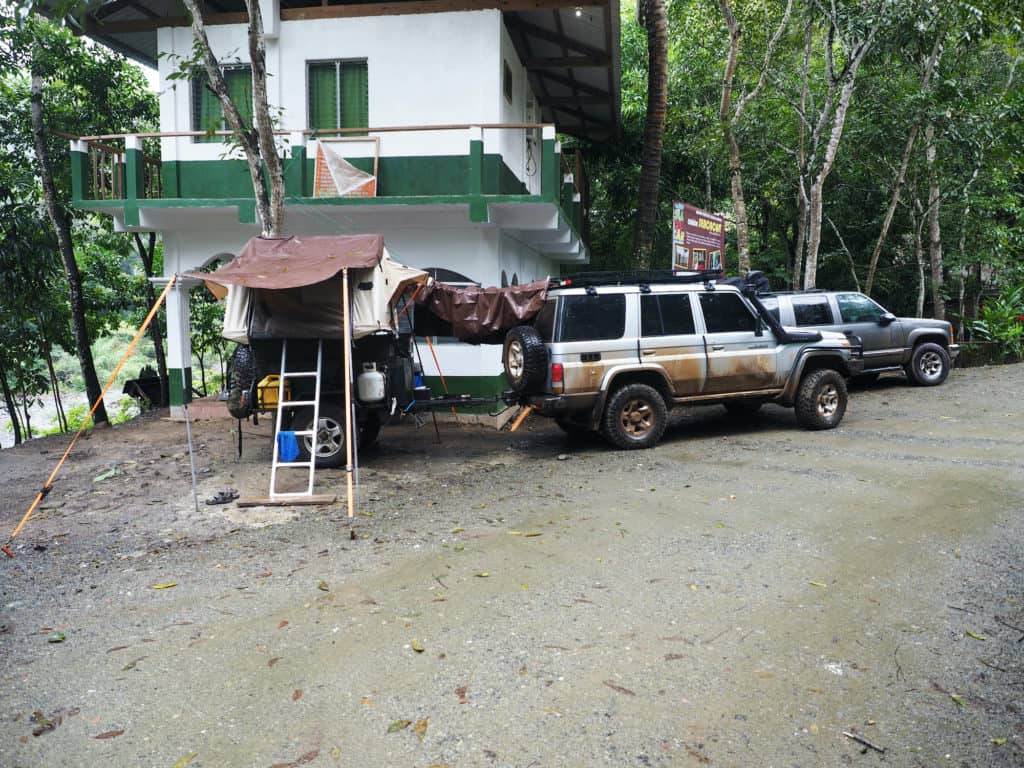


Henri and Lisenia, who manage the reserve, let us take over the restaurant tables, set up our chuck box and stoves on the ledge of their kitchen, use the kitchen “pila” (a sort of sink/ water reservoir) for washing dishes, and make ourselves at home. It couldn’t have been a better set up for us.
Normally, they would have visitors camp on a nice sandy ledge below the restaurant, or under the roof of a bar they only open up during Easter. Those areas aren’t very big, though, so if there are a lot of visitors when you go, you might have to pitch your tents in the soccer field down the road. It looks like a nice spot (provided it isn’t raining), but it is a long way from the bathrooms and showers.
How long to stay at Reserva Natural Cañon Seacacar
The two main activities to do here are to hike the nature trails up to the overlook and to go tubing. If you want to pack both into one day, it’s possible to do so, just make sure you set up your tubing tour before your arrival.

For a slower pace, you can spread out the activities over two days.
I spent three nights and two full days at Seacacar with my friends and family. We went hiking one day and tubing the next, then spent the afternoon playing cards, reading, and relaxing. If it hadn’t been so rainy, I probably would have spent more time swimming in the river and exploring.
Costs At Reserva Natural Cañon Seacacar
The following are the standard rates at Cañon Seacacar as of December 2021. Please confirm the prices yourself before going.
Payment is in cash only.
Transportation Fees:
Pickup or dropoff from the Balneario El Boquerón or Balneario Tío Polo costs Q150 one way.
Entrance Fees:
Q15 per person to use the facilities and bathe in the river
Q30 per person to access all of the facilities and the hiking trails

Note: Sometimes they can create packages for you based on how long you plan to stay, how many are in your group, and what activities you want to do. Get in touch ahead of time through the contact info below.
Tubing Tour:
Q120 per person to tube down the river and return on the hiking trail
Q140 per person to tube down the river and return upriver by boat
Note: If you have your own tube, it costs Q10 to go on the tour, plus either Q15 to return on the hiking trail or Q25 to return upriver by boat. Additional fees may apply for the guide.
Tip: Water shoes or hiking shoes are essential, especially if you plan to walk back on the trail.
If you are staying in the rooms or camping, you may be able to get a cheaper rate. For example Q100 for tubing or Q120 for tubing and returning upriver by boat.
Camping Fees
Q35 per tent per night if you bring your own tent
Q100 to rent a tent and camp in it
There are two tents available for rent at Seacacar, for three and four people respectively
Accomodations

Q75 per person to stay in the eight-person bunkhouse (a dormitory-style room with bunk beds)
Q250 for a double room with a shared bathroom
Q200 for a single room with a shared bathroom
Q300 for a double room with a private bathroom
Q250 for a single room with a private bathroom
Note:
Extra people in any room costs Q75 per person.
There is no hot water available for showers because the reserve is off-grid and relies on solar power
There is no internet or cell service in the Seacacar, so it might take a day to receive a reply on reservations. Walk-ins are welcome.
Restaurant
Breakfasts are usually in the Q30-35 range and may include a combination of eggs, black beans, tortillas, and fresh fruit, coffee or tea.
Lunches and dinners cost from Q50 up, depending on what you order. Possible menus include soup, pasta, steamed vegetables, chicken, fajitas, rice and beans, burritos, etc.
If you plan to eat at the restaurant, please let them know well in advance so they can go into El Estor for groceries.
Important things to know about Reserva Cañon Seacacar
- Payment is in cash only
- There is no cell service right at the reserve. You must drive or walk 1.4 kilometers (0.8 miles) up the road, or hike up to the overlooks on the trails to get signal
- If you go to Cañon Seacacar, please be respectful, don’t litter or otherwise pollute the area.
Interesting facts about Reserva Natural Cañon Seacacar
This sustainable tourism project was the brainchild of Paul Heesaker, an American who came upon Seacacar during an exploratory kayaking expedition in 1995. He presented his idea to the community and then helped fundraise for startup costs. Community members donated their time to help build and develop the area. To learn more, visit the Rios Fund.
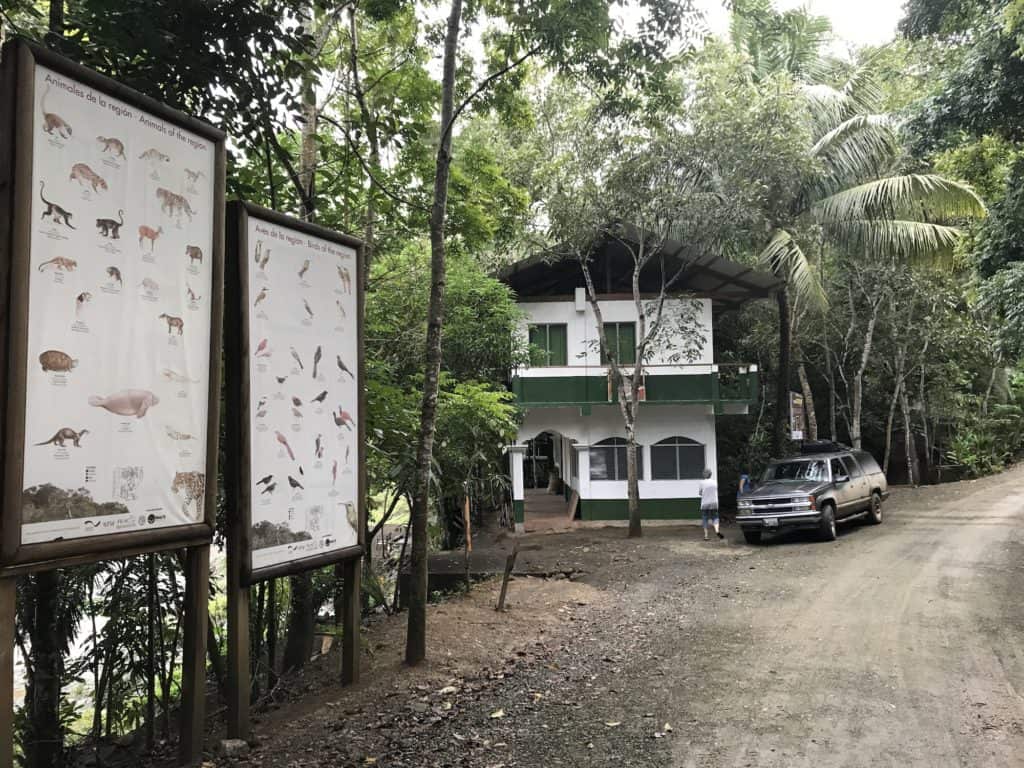
Proceeds from tourism help fund the community’s school, which currently offers grades 7 to 9. The students come from different communities along the Sauce river basin and learn through both classroom experiences and hands-on work in tourism, sustainable agriculture, and reforestation. Once students graduate from ninth grade, they can continue their education at Ak’ Tenamit, a vocational boarding school 70 miles away.
The community was originally named A’acacar, after a muscular fish that populates the Sauce River. The male fish has a snout that resembles a pig, so the name in K’ekchi essentially means “pig fish.” In order to make the name easier for visitors to pronounce, locals decided to change the name to Seacacar (pronounced say-ah-kah-car).
Contact information for Reserva Natural Cañon Seacacar
For more information on visiting El Boquerón Izabal at Reserva Natural Cañon Seacacar, or to make a reservation, I recommend calling or messaging my contact Ramiro:
Ramiro Takaj: +502 4861 6889
There is no cellular signal at Cañon Seacacar, so your best bet is to send a Whatsapp message. Ramiro will get back to you once he returns to an area with cell service.

Ramiro was a great help to us as we were planning our trip and gave us updated information on the road conditions and the political climate in the area (there had been recent protests against the nickel mine so we wanted to make sure it was safe to go).
How to get toReserva Natural Cañon Seacacar
In this section, I’ll explain how to get to El Boquerón Izabal at the Reserva Natural Cañon Seacacar in your own car or on public transportation.
How to get there by car
If you have your own four-wheel-drive vehicle you can drive all the way to Cañon Seacacar. When we went, the military had just finished fixing up the roads and they were in fabulous condition. My dad still put the suburban in four-wheel-drive-low to get down the hill without using the brakes too much, as it is steep with switchback turns.
Waze couldn’t calculate the endpoint, so we tried Google Maps instead, and it worked well to get us all the way to the reserve. Check out the route below.
There are a few sections of dirt road after Río Dulce, but it isn’t too rough. You can come from the direction of Río Dulce or from the direction of El Estor.
If you don’t have a four-wheel-drive vehicle, you can leave your car at the Balneario El Boquerón for a parking fee. Ramiro Takaj (see the contact section above) can arrange transportation for you from the Balneario to Seacacar. Make sure you arrange this ahead of time, however, since there is no cell signal right at the reserve.
How to get to Reserva Natural Cañon Seacacar on public transportation
If you are going to El Boquerón on public transportation, you can catch a bus from Guatemala City to Río Dulce, then find a microbus going to El Estor. You can catch one by going to the intersection of the main highway through Río Dulce and the highway to El Estor. The trip costs Q20.
If you are in good physical condition and are up for backpacking, you can hike in on the trail starting at Balneario Tío Polo. Alternatively, get off at the turnoff towards Cañon Seacacar (coordinates: 15.547511601145068, -89.30162930230335) and either walk the 6 kilometers in, hitchhike (though this is tricky, cars going in are usually full), or prearrange transportation with the reserve.
Check out the Rios Fund info and directions tab for more detailed information and arrival options, or talk to Ramiro Takaj (see contact section).
Tour Companies that lead tours to El Boquerón
Cassa Zenda offers tailored adventures to many Izabal destinations, including El Boquerón.
You can also book a tour with an Inguat certified local guide. These guides have a great knowledge of the area and can arrange everything for you, from the itinerary to lodging, transportation, and food.
Contact a local guide:
Name: Francisco Rolando Requena
Mobile/Whatsapp: +502 5419 3323
Languages: English & Spanish
Area of Expertise: Lake Izabal and Puerto Barrios, including manatee tours at the Bocas de Polochic, El Boquerón, Finca el Paraíso, and Castillo de San Felipe.
Contact information for other guides is available by visiting or phoning Inguat offices (Guatemala’s Tourism Institute).
Places to stay near el El Boquerón Izabal
If you are going to visit Reserva Natural Cañon Seacacar, I’d recommend spending the night there. They have a variety of options ranging from a bunkhouse to private rooms.
There are also a variety of hotels in nearby El Estor. I haven’t stayed at any of these places so do your own research, but here’s a list to get you started:
Finca El Paraíso

I’ll talk more about Cascadas El Paraiso in another post, which is a must-see stop only 30 minutes from Cañon Seacacar, however, there is also a hotel, restaurant, and tourist center by this name, located on the waterfront of Lake Izabal. They have several air-conditioned bungalows and a waterslide into the lake. They also offer camping at Q40 per person per night.
Brisas Del Lago Finca El Paraíso
This hotel and event center is located right beside the option mentioned above, so if you’re not sure which one you like best, it’s easy to swing by both to see the facilities before you decide.
Hotel Ecológico Cabañas del Lago
This hotel is located in El Estor and is a nature sanctuary. It looks like a beautiful and top-rated place to stay. You can camp here for Q75 a night, or opt for one of their rooms. As a perk for us animal lovers, they accept pets.

A room for four people costs Q450 with a fan or Q550 with an air conditioner. For five people it costs Q550 with a fan or Q650 with an air conditioner.
Phone/Whatsapp number: +502 3221-2883
Hotel Yair El Estor
This hotel is located along the lakeshore in El Estor and could be another good option.
Chalet El Castillo
For a more upscale option, check out this chalet. It has swimming pools, a private marina, wi-fi, and jet skis. There are plenty of restaurants nearby.
Is it safe to visit El Boquerón Izabal?
If you are visiting Reserva Natural Cañon Seacacar it’s important to only swim in the designated areas and not to go too far out in the river. The current is very strong and can carry you downstream into rough rapids and whirlpools that you may not survive. The dangers of these sections of the river have given rise to a legend about a pair of giants that live in the water and snatch bodies down to the depths to feed on their souls. Creepy right? So heed the warnings.

There is a large nickel mine located right outside El Estor so sometimes there are protests related to it. Shortly before our trip, the municipality of El Estor was placed under a state of emergency and a large quantity of police flooded into the area to dislodge a group of protesters. Get in touch with your hotel, a local guide, or Ramiro from Cañon Seacacar to check on the political climate before your trip.
Best time to visit El Boquerón Izabal
You can visit El Boquerón at any time of year, but I asked several locals when they thought the best time of year would be, and most recommended a range of months between January and April. April is probably the hottest month, whereas January, February, and March are probably cooler and less likely to be rainy.

As we discovered, November and December are some of the rainiest months in Izabal! It rained every single day multiple times, ranging from a light mist to a downpour and everything in between. We caught only a few glimpses of blue sky during our trip, and the sun struggled to burn through the haze. The river was also the color of milk chocolate from the mud, rather than the clear greeny-blue we were expecting, but I think our tubing ride was probably more fun with the extra water shooting us downstream at speed.
According to one of our guides, the river can rise fifteen feet after heavy rainfall and up to twenty-one feet during a hurricane. In fact, during Hurricane Iota in 2020, the river rose all the way up to the restaurant at Seacacar and washed away several covered areas they had closer to the riverbank. If you happen to go when there is extreme rainfall, you may not be able to go tubing.
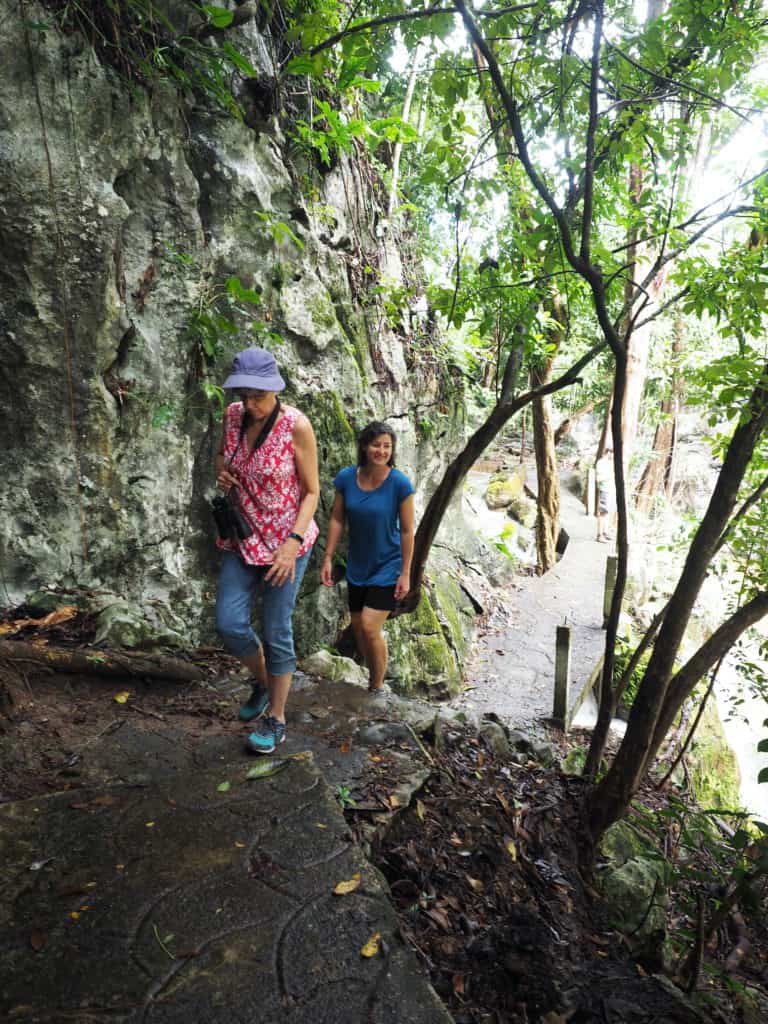
Most of our clothes, once they got wet, stayed wet (unless we wore them and dried them with our body heat). That said, despite the inconvenience of doing everything in the rain (and not even having a rain jacket with us… that’s how naive we were about the climate), we didn’t let it hold us back much. We enjoyed all of the same activities as we would have had it been sunny, like tubing, and hiking. Of course, we also spent time more time playing card games and drinking tea than we would have otherwise. We also slept much better than we would have in the heat.
Climate at El Boquerón Izabal
The climate is tropical, with a fair amount of rain year-round, especially from August to December. It is probably driest and coolest (or less scorching) between January and March.
No matter when you go, take a rain jacket!
Other places to visit near El Boquerón Izabal
While you’re in the area, be sure to check out Cascadas el Paraíso – a lovely hot spring waterfall, Castillo San Felipe, and the scenic town of El Estor. (Though if you swim on the public beach, watch out for glass!) You can also have an exotic farm-to-table meal and fruit farm tour at Vivero Frutas del Mundo.

The Wrap-up
El Boquerón Izabal is a fabulous place to visit. I can’t recommend it enough, especially the Reserva Natural Cañon Seacacar. I had a wonderful time there and would love to go back again.
Looking for other nature activities in Guatemala? Check out 35 Amazing Things to Do in Lake Atitlán, Laguna Lachuá – Guatemala’s Hidden Gem, or Best ofGuatemala’s Black Sand Beaches.
***GUATEMALA TRAVEL PLANNING GUIDE***
Should I buy Guatemala travel insurance?
YES — Personally, I always travel with travel insurance because it gives me extra peace of mind. SafetyWing is an excellent travel insurance company that’s quite affordable. Plus, if you travel longterm, it’s a snap to renew on a month to month basis. You can keep renewing for up to a year and still pay the same deductible.
Where’s the best place for finding cheap flights to Guatemala?
When I purchase a ticket, I always search several different sites. Kayak and Expedia are great places to start running a search. Spirit is usually the cheapest carrier, but American Airlines and United also sometimes offer excellent deals.
What’s the best way to book my Guatemala accommodations?
I recommend booking.com for finding and booking hotels in Guatemala. For vacation rentals, I recommend VRBO.com — it offers beautiful and unique spots to stay.
What’s the best way to book Guatemala tours?
Viator is a great tour booking site with several excellent options available in Guatemala’s main tourist areas including Tikal, Atitlán, Antigua, and Acatenango. There’s a nice range of prices and options available.
Can you drink the water in Guatemala?
No – Don’t drink the tap water! Instead, buy purified water from any corner store or grocery store in Guatemala.
Be sure to brush your teeth with that water as well to avoid getting sick. And hydrated, especially when traveling to high elevations.
Do I need a visa for Guatemala?
Probably not — Visitors to Guatemala from “Category A” countries like the United States, Canada, the UK, New Zealand, Australia, and most European countries are automatically given a 90-day tourist visa (in the form of a passport stamp) when entering Guatemala.
This visa is valid for Guatemala, Nicaragua, Honduras, and El Salvador. At the end of 90 days, it can be renewed once at Guatemala’s Migración without leaving the country.
After 180 days, you will have to travel outside of Central America before returning. Check to see if you need a visa.
Will my phone work in Guatemala?
It’s possible, but check with your provider in advance to see if Guatemala is covered. If not, you can easily pick up a local SIM card.
There are essentially only two carriers in the country: TIGO and CLARO. Both have good coverage.



